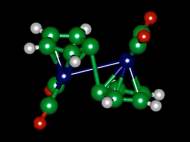MIT researchers on a path to revive solar heat harvesting
 Researchers explored the thermo-chemical approach to capture solar energy since the 1970s, but nobody could find a chemical that could reliably and reversibly switch between two states, absorbing sunlight to go into one state and then releasing heat when it reverted to the first state. Such a compound was discovered in 1996, but it included ruthenium, a rare and expensive element. Researchers at MIT have revealed that another material, called fulvalene diruthenium, can accomplish similar energy storage and release properties.
Researchers explored the thermo-chemical approach to capture solar energy since the 1970s, but nobody could find a chemical that could reliably and reversibly switch between two states, absorbing sunlight to go into one state and then releasing heat when it reverted to the first state. Such a compound was discovered in 1996, but it included ruthenium, a rare and expensive element. Researchers at MIT have revealed that another material, called fulvalene diruthenium, can accomplish similar energy storage and release properties.
Essentially, the molecule undergoes a structural transformation when it absorbs sunlight, putting the molecule into a higher-energy state where it can remain stable indefinitely. Then, triggered by a small addition of heat or a catalyst, it snaps back to its original shape, releasing heat in the process. But the team found that the process is a bit more complex.
“It turns out there’s an intermediate step that plays a major role”, said Jeffrey Grossman, the Carl Richard Soderberg Associate Professor of Power Engineering in the Department of Materials Science and Engineering. In this intermediate step, the molecule forms a semistable configuration partway between the two previously known states. The two-step process helps explain why the molecule is so stable, why the process is easily reversible and also why substituting other elements for ruthenium has not worked so far..
In effect, explained Grossman, this makes it possible to produce a “rechargeable heat battery” that can repeatedly store and release heat gathered from sunlight or other sources. In principle, Grossman said, a fuel made from fulvalene diruthenium, when its stored heat is released, “can get as hot as 200 degrees C, plenty hot enough to heat your home, or even to run an engine to produce electricity.”
“It takes many of the advantages of solar-thermal energy, but stores the heat in the form of a fuel. It’s reversible, and it’s stable over a long term. You can use it where you want, on demand. You could put the fuel in the sun, charge it up, then use the heat, and place the same fuel back in the sun to recharge”, said Grossman
In addition to Grossman, the work was carried out by Yosuke Kanai of Lawrence Livermore National Laboratory, Varadharajan Srinivasan of MIT’s Department of Materials Science and Engineering, and Steven Meier and Peter Vollhardt of the University of California, Berkeley. Their report “Mechanism of Thermal Reversal of the (Fulvalene)tetracarbonyldiruthenium Photoisomerization: Toward Molecular Solar–Thermal Energy Storage” was published in the journal Angewandte Chemie.
Grossman plans to collaborate with Daniel Nocera, the Henry Dreyfus Professor of Energy and Professor of Chemistry, in order to design new, inexpensive materials that exhibit this same reversible process. The tight coupling between computational materials design and experimental synthesis and validation should accelerate the discovery of promising new candidate used for solar thermal fuels.









“Rechargeable heat battery” that can repeatedly store and release heat gathered from sunlight or other sources, is indeed a breakthrough technology in the field. My congratulations to MIT Researchers.
Dr.A.Jagadeesh Nellore(AP),India